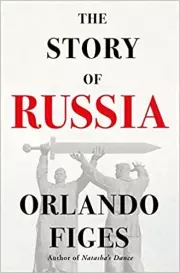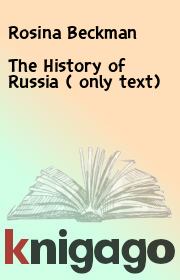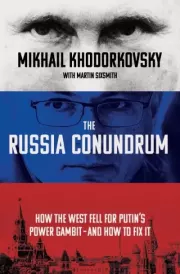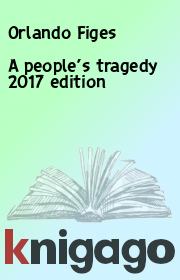Orlando Figes - The Story of Russia
 | Название: | The Story of Russia |
Автор: | Orlando Figes | |
Жанр: | Старинная литература | |
Изадано в серии: | неизвестно | |
Издательство: | неизвестно | |
Год издания: | 2022 | |
ISBN: | неизвестно | |
Отзывы: | Комментировать | |
Рейтинг: | ||
Поделись книгой с друзьями! Помощь сайту: донат на оплату сервера | ||
Краткое содержание книги "The Story of Russia"
“This is the essential backstory, the history book that you need if you want to understand modern Russia and its wars with Ukraine, with its neighbors, with America, and with the West.”
―Anne Applebaum, author of Twilight of Democracy and Red Famine
Named a Most Anticipated Book of the Year by Publishers Weekly and Kirkus Reviews
From “the great storyteller of Russian history” (Financial Times), a brilliant account of the national mythologies and imperial ideologies that have shaped Russia’s past and politics―essential reading for understanding the country today
The Story of Russia is a fresh approach to the thousand years of Russia’s history, concerned as much with the ideas that have shaped how Russians think about their past as it is with the events and personalities comprising it. No other country has reimagined its own story so often, in a perpetual effort to stay in step with the shifts of ruling ideologies.
From the founding of Kievan Rus in the first millennium to Putin’s war against Ukraine, Orlando Figes explores the ideas that have guided Russia’s actions throughout its long and troubled existence. Whether he's describing the crowning of Ivan the Terrible in a candlelit cathedral or the dramatic upheaval of the peasant revolution, he reveals the impulses, often unappreciated or misunderstood by foreigners, that have driven Russian history: the medieval myth of Mother Russia’s holy mission to the world; the imperial tendency toward autocratic rule; the popular belief in a paternal tsar dispensing truth and justice; the cult of sacrifice rooted in the idea of the “Russian soul”; and always, the nationalist myth of Russia’s unjust treatment by the West.
How the Russians came to tell their story and to revise it so often as they went along is not only a vital aspect of their history; it is also our best means of understanding how the country thinks and acts today. Based on a lifetime of scholarship and enthrallingly written, The Story of Russia is quintessential Figes: sweeping, revelatory, and masterful.
Читаем онлайн "The Story of Russia". Главная страница.
- 1
- 2
- 3
- . . .
- последняя (101) »
The Story of Russia
For Stephanie.
Again. Always.
By the same author
Peasant Russia, Civil War: The Volga Countryside in Revolution, 1917–21
A People’s Tragedy: The Russian Revolution, 1891–1924
Interpreting the Russian Revolution: The Language and Symbols of 1917 (with Boris Kolonitskii)
Natasha’s Dance: A Cultural History of Russia
The Whisperers: Private Life in Stalin’s Russia
Crimea: The Last Crusade
Just Send Me Word: A True Story of Love and Survival in the Gulag
Revolutionary Russia, 1891–1991
The Europeans: Three Lives and the Making of a Cosmopolitan Culture
Contents
Introduction
1 Origins
2 The Mongol Impact
3 Tsar and God
4 Times of Trouble
5 Russia Faces West
6 The Shadow of Napoleon
7 An Empire in Crisis
8 Revolutionary Russia
9 The War on Old Russia
10 Motherland
11 Ends
Notes
Picture Credits
Index
Acknowledgements
A Note on the Author
Plate Images
Introduction
On a cold and grey November morning, in 2016, a small crowd gathered on a snow-cleared square in front of the Kremlin in Moscow. They were there to witness the unveiling of a monument to Grand Prince Vladimir, the ruler of Kievan Rus, ‘the first Russian state’, between 980 and 1015. According to legend, Vladimir was baptised in the Crimea, then part of the Byzantine Empire, in 988, thus beginning the conversion of his people to the Eastern Orthodox Church. Russia’s main religious leaders – the patriarch of Moscow and All-Russia, the Catholic ordinariate, the grand mufti, the chief rabbi and the head of the Buddhist Sangha – were all in attendance in their multicoloured robes.
The bronze figure, bearing cross and sword, stood at over twenty metres tall. It was the latest in a long series of elephantine shrines to Vladimir, all erected since the fall of Communism in the same kitsch ‘Russian’ national style developed in the nineteenth century. Other Russian towns – Belgorod, Vladimir, Astrakhan, Bataisk and Smolensk – had built monuments to the grand prince with funding from the state and public subscriptions. The Moscow statue was financed by the Ministry of Culture, a military history society and a motorcycle club.1
Another Vladimir, President Putin, gave the opening address. Even as he spoke he managed to look bored. He seemed to want the ceremony to be done as soon as possible – perhaps the reason why it started earlier than planned, when the film director Fedor Bondarchuk, who had vocally supported the recent Russian annexation of Ukrainian Crimea, invited Vladimir Vladimirovich to the microphone. Reading in a flat tone from his script, Putin noted the symbolism of the date for this unveiling, 4 November, Russia’s Day of National Unity. The grand prince, he proclaimed, had ‘gathered and defended Russia’s lands’ by ‘founding a strong, united and centralised state, incorporating diverse peoples, languages, cultures and religions into one enormous family’. The three modern countries that could trace their origins to Kievan Rus – Russia, Belarus and Ukraine – were all members of this family, Putin continued. They were a single people, or nation, sharing the same Christian principles, the same culture and language, which, he suggested, formed the Slavic bedrock of the Russian Empire and the Soviet Union. His point was echoed by the patriarch Kirill, who spoke next. If Vladimir had chosen to remain a pagan, or had converted only for himself, ‘there would be no Russia, no great Russian Empire, no contemporary Russia’.
Natalia Solzhenitsyn, the writer’s widow, gave the third and final speech, short and different in tone. The traumatic history of Russia’s twentieth century had, she said, divided the country, and ‘of all our disagreements, none is more divisive than our past’. She ended with a call to ‘respect our history’, which meant not just taking pride in it but ‘honestly and bravely judging evil, not justifying it or sweeping it under the carpet to hide it from view’.2 Putin looked uncomfortable.
The Ukrainians were furious. They had their own statue of the grand prince, Volodymyr as they call him. It was built in 1853, when Ukraine had been part of the Russian Empire, high up on the right bank of the Dnieper River overlooking Kiev, the Ukrainian capital. After the collapse of the Soviet Union in 1991, the statue had became a symbol of the country’s independence from Russia. Within minutes of the ceremony’s closing in Moscow, Ukraine’s official Twitter account posted a picture of the Kiev monument with a tweet in English: ‘Don’t forget what [the] real Prince Volodymyr monument looks like.’ The Ukrainian president, Petro Poroshenko, elected in the wake of the 2014 Maidan revolution, accused the Kremlin of appropriating Ukraine’s history, comparing its ‘imperial’ behaviour to the Russian annexation of the Crimea, part of sovereign Ukraine, just before his election.3
Kiev and Moscow had been fighting over Volodymyr/Vladimir for several years. The monument in Moscow had been made a metre taller than the one in Kiev, as if to assert the primacy of Russia’s claim to the grand prince. While Putin had enlisted Vladimir as the founder of the modern Russian state, the Ukrainians claimed Volodymyr as their own, the ‘creator of the medieval European state of Rus-Ukraine’, as he had been described by Poroshenko in a 2015 decree on the millennium of the grand prince’s death in 1015 (the fact that the term ‘Ukraine’ would not appear in written sources until the end of the twelfth century – and then only in the sense of okraina, an old Slav word for ‘periphery’ or ‘borderland’ – was conveniently overlooked). A few months later, Poroshenko added that Volodymyr’s decision to baptise Kievan Rus had been ‘not only a cultural or political decision, but a European choice’ by which Kiev had joined the Christian civilisation of Byzantium.4 The message was clear: Ukraine wanted to be part of Europe, not a Russian colony.
Both sides were calling on the history of Kievan Rus – a history they share – to reimagine narratives of national identity they could use for their own nationalist purposes. Historically, of course, it makes little sense to talk of either ‘Russia’ or ‘Ukraine’ as a nation or a state in the tenth century (or indeed at any time during the medieval period). What we have in the conflict over Volodymyr/Vladimir is not a genuine historical dispute, but two incompatible foundation myths.
The Kremlin’s version – that the Russians, the Ukrainians and the Belarusians were all originally one nation – was invoked to validate its claim to a ‘natural’ sphere of interest (by which it meant a right of interference) in Ukraine and Belarus. Like many Russians of his generation, schooled in Soviet views of history, Putin never really recognised the independence of Ukraine. As late as 2008, he told the US president that Ukraine was ‘not a real country’ but a historic part of greater Russia, a borderland protecting Moscow’s heartlands from the West. By
--">- 1
- 2
- 3
- . . .
- последняя (101) »
Книги схожие с «The Story of Russia» по жанру, серии, автору или названию:
 |
| Rosina Beckman - The History of Russia ( only text) Жанр: Старинная литература Год издания: 101 |
| Encyclopaedia Britannica - Russia Жанр: Старинная литература Год издания: 101 |
 |
| Mikhail Khodorkovsky-ua - The Russia Conundrum - Mikhail Khodorkovsky-ua Жанр: Старинная литература Год издания: 2022 |
 |
| Orlando Figes - A people's tragedy 2017 edition Жанр: Старинная литература Год издания: 101 |


